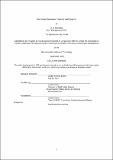Real estate derivatives : products and prospects
Author(s)
Eisenberg, Oriel
DownloadFull printable version (767.2Kb)
Other Contributors
Massachusetts Institute of Technology. Center for Real Estate. Program in Real Estate Development.
Advisor
David Geltner.
Terms of use
Metadata
Show full item recordAbstract
The paper reviews the development, structure and trade of past real estate equity hedging instruments. The reviewed products represent a wide array of real estate derivatives, covering multiple property types, index methodologies and trading domains. Based on a series of interviews with leading product developers, market makers, traders and scholars, the paper examines and defines the unique features of the different products and analyzes their value proposition, market conditions and performance. In order to gain an overall perspective on the prospects of real estate derivatives, the paper discusses types of market demand for real estate investing and hedging. In this context, we present real estate debt hedging instruments and compare their trade and use with past real estate equity products. In addition, we discuss recent regulatory acts and their influence on trading requirements and costs, market making and players as well as market efficiency. In the last chapter, the paper presents Pure Property, a current real estate hedging solution, marketed by NAREIT and FTSE. We research Pure Property and compare it to past products. The paper points on Pure Property's new concept and its implications on asset valuation, product functionality and trading liquidity. The paper studies the ETF structure of the product and its contribution to arbitrage activity. For the above-mentioned advantages, the paper predicts that Pure Property is likely to establish a liquid, real estate hedging market.
Description
Thesis (S.M. in Real Estate Development)--Massachusetts Institute of Technology, Program in Real Estate Development in Conjunction with the Center for Real Estate, 2013. This electronic version was submitted by the student author. The certified thesis is available in the Institute Archives and Special Collections. Cataloged from student-submitted PDF version of thesis. Includes bibliographical references (pages 78-79).
Date issued
2013Department
Massachusetts Institute of Technology. Center for Real Estate. Program in Real Estate Development.; Massachusetts Institute of Technology. Center for Real EstatePublisher
Massachusetts Institute of Technology
Keywords
Center for Real Estate. Program in Real Estate Development.